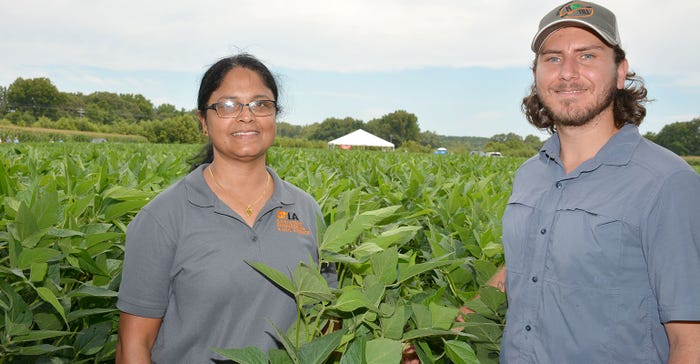
Cover crops will pay for themselves, according to speakers at the annual Milan No-Till Field Day — but maybe not every year and probably not the first year.
Several factors affect how well crops planted into a cover perform, including the cover crop mix, weather, and planting date.
Brian Kozlowski, research associate in the University of Tennessee Department of Biosystems Engineering and Soil Science, discussed planting methods and the effect cover crops have on crop yields at one of 16 research tour stops.
Kozlowski said ongoing studies evaluate the effect various cover crop mixes and planting techniques have on a soybean-corn rotation system. One study examines the planting date, another looks at seeding method (broadcast vs drill).
“Plant as early as possible,” Kozlowski said, “to obtain as much biomass as possible. Our results show that earlier-planted cover crops tend to produce more aboveground biomass, and thus suppress more weeds.”
Weather is a factor with cover crop stands. “Too much or too little moisture will affect emergence and cover crop establishment,” he said.
See also: Successful use of cover crops may require seed treatments
The seeding method study shows no significant soybean or corn yield differences in years with adequate moisture. “In dry or wet years, cover crop establishment was poor if the seed was broadcast, so drilling is recommended.”
He said planting depth is also easier to control with a drill.
Studies also considered cover crop options, including, single species, two species, or multispecies mixes. The seeding method study compares six cover crop treatments (wheat; cereal rye; cereal rye and crimson clover; cereal rye and hairy vetch; a multispecies mix of cereal rye, oats, crimson clover, turnips, and radish; and an unseeded control).
“In drier years, when summer rainfall distribution was poor, yields of soybean following multispecies cover crops were significantly increased compared to no cover crops.”
Kozlowski says the difference likely is a result of improved soil physical properties, increased water infiltration and significant crop yield response.
The study is being conducted by Kozlowski and Forbes Walker, associate professor, UT Department of Biosystems Engineering and Soil Science.
Soil Property Effect
Manny Sabbagh, a master’s degree candidate, discussed the impact of cover crops on soil physical properties, research underway with Sindhu Jagadamma, assistant professor, UT Department of Biosystems Engineering and Soil Science.
The study includes six cover crop treatments, including wheat, cereal rye, cereal rye plus hairy vetch, cereal rye plus crimson clover, soil health mix (crop mixture of cereal rye, crimson clover, hairy vetch, daikon radish, turnips, and whole oats), and a no cover crop control.
“A mixture of grasses, legumes, and brassicas integrates the benefits of each into the cover crop,” Sabbagh said.
He added that the deep tap roots of the brassicas—turnips, radishes and rapeseed—push deep into the soil profile and “scavenge for nutrients.” He said the grasses mitigate soil erosion and limit weed emergence. The legumes add nitrogen.

Sindju Jagadamma, left, and Manny Sabbagh discussed cover crops and soil physical properties on a Milan No-Till Field Day tour stop.
“The mix retains the highest amount of soil moisture,” Sabbagh said. The study shows that soil moisture and soil inorganic nitrogen contents were higher from plots planted with double- and multispecies cover crops.
“Soil organic matter did not change across the cover crop treatments. Overall, planting a combination of species shows promising results for a healthy soil by improving nitrogen availability and water retention.”
See also: 30th Milan No-Till Field Day offered ample evidence of the value of conservation tillage
He said the legume can account for as much as 60 to 80 pounds of nitrogen per acre, with a single species. In a mix, the nitrogen level drops since other species take up the nutrients.
The field study also shows that decomposition following incorporation of the cover crop residue into the soil is rapid, 35 percent to 40 percent within the first month. The mix decomposed faster than the other options.
“We like the mix,” Jagadamma said.
Rotation Advantages
Amin Nouri, postdoctoral research associate, UT Department of Biosystems Engineering and Soil Science, reported on long-term studies examining the impact of cover crops and crop rotation on soil physical properties.
No-till in a low-residue cropping system, Nouri said, offers limited protection against surface erosion and little benefit to soil physical properties. In fact, that combination may be no better than conventional tillage. Cover crops change the dynamic, however.
“Our result showed that long-term incorporation of cover crops — in particular, vetch with no-tillage — significantly improved the initial infiltration, cumulative infiltration, and water transmission,” Nouri said.
As in other studies reported above, he said differences in soil moisture content were more evident in drier periods of growing seasons, “resulting in 28.6 percent and 36.4 percent greater moisture content in vetch cover crop and no-tillage than no cover crop and conventional tillage, respectively.”
His studies included several cropping systems, including continuous cotton, back-to-back corn and soybean crops, and rotations — cotton-corn, corn-soybean, soybean-cotton — seeded no-tillage with winter fallow.
Among cover crops, the greatest cotton lint yield was measured in hairy vetch (1672 kg ha-1). No-tillage (1728 kg ha-1) produced significantly higher yield than conventional tillage (1541 kg ha-1).
The rotation study showed that cropping in rotation provided no advantage over monocropping. “However, corn, either as continuous cropping or when rotated with cotton and soybean, improved soil physical properties and/or increased yield. Incorporation of cotton in the cropping system decreased near-surface root penetrability by 17 percent compared to corn and soybean cropping systems.”

Amin Nouri, left, and Safak Ceylan, show results from cover crop and no-till studies at the Milan No-Till Field Day.
Advantage When Dry
During dry periods, corn-soybean and continuous corn saw an 18 percent increase in soil moisture content. “Water infiltration and transmission were greater under corn-soybean and continuous soybean, while the highest plant-available water content was found in corn-soybean and continuous corn.”
Nouri said the highest corn and soybean yield came from a corn-soybean rotation. A cotton-corn rotation produced the highest cotton yield.
Speakers agreed that cover crops are making a difference in Tennessee row crop production, including saving soil and increasing soil moisture retention.
“In recent years, cover crops have become an important component of many cropping systems in west Tennessee, especially in corn-soybean rotations,��” Kozlowski said. “The addition of winter cover crops can have many benefits to a cropping system, including reducing soil erosion over the winter months, weed suppression, increasing soil organic matter, increasing water infiltration and improving overall soil health. If legumes are used as a cover crop, nitrogen fertilizer costs can be reduced.”
“Producers are very enthusiastic about the multiple benefits of cover cropping such as controlling soil erosion, suppressing weed growth, reducing nutrient leaching, and increasing soil organic matter content,” Sabbagh said.
This year marked the 30th Milan No-till Field Day, which started in 1981 as a venue to demonstrate no-till basics and present new technologies that work into no-till systems.
About the Author(s)
You May Also Like






